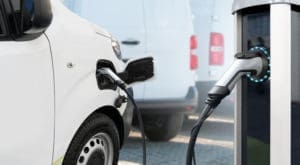Home > Blog > The Role of the Courier Industry in Reducing its Carbon Footprint
Carbon footprint refers to the amount of carbon that an organisation, person or activity produces. Everyone and everything has a carbon footprint, and what we do affects how much of an impact our carbon footprint has on the environment.
The UK government outlined its commitments to the environment and has pledged to reduce carbon emissions within the UK, with a strategy that plans to achieve net zero emissions by 2050. They have pledged that by 2035, emissions will have reduced to 78%. As a result of these stringent targets, companies are required to look at the carbon footprint that they create and find ways in which they can reduce this.
With consumers increasingly relying on home deliveries for a wider range of different goods, and more and more customers choosing to spend more with companies that show sustainable efforts, now is the time for the courier industry to look at how it can reduce its own carbon footprint and create a more sustainable delivery network for the future.
Parcel deliveries to people’s homes cover a significant number of miles, and this means that they are a huge contributor of greenhouse gas emissions. This is increased when deliveries fail and must be rescheduled, or when products are returned.
In 2022-23 the average parcel delivered by Royal Mail generated 218g CO2e. But what about courier deliveries?
Overall, the figures for these are slightly lower. With the typical home delivery round for a courier covering fifty miles, with an assumption of 120 drop-offs and an average of 0.42 miles between each drop-off point, there is a carbon footprint of around 181g of CO2e per parcel.
Some companies have already taken steps to reduce the carbon footprint of their deliveries through the use of “green” features. Some top supermarkets have introduced green delivery options; –slots indicating there is already a delivery taking place at that time nearby to the customer.
Amazon has introduced the concept of Amazon Day Delivery, where customers who buy a number of items over the course of several days can choose to have them delivered all together on a designated day and thereby reducing the carbon footprint of their delivery. Amazon Day Deliveries saved 200 million boxes in 2023.
Despite the carbon emitted by deliveries, statistics indicate that home delivery is, in fact, 24 times more friendly to the environment than going shopping in your own car.
Electric vehicles are one of the most obvious steps that courier companies can take to reduce their carbon footprint. With an increase in the availability of electric vehicles, there has never been a better time for companies to consider adding them to their delivery fleet.
Some larger companies are already taking the lead when it comes to electric vehicles, with Amazon pledging to have 100,000 electric vehicles on the road by 2030. Whilst the availability of electric vehicles may have been slowed during the pandemic, things are once again picking up, and courier companies are looking to make their move to electric.
Logistics software also has its part to play in making the logistics industry more carbon efficient. Software that can plot out the best and most fuel-efficient route for a day’s worth of deliveries can really make a difference to the carbon footprint of each parcel they deliver.
Integrated digital technology and GPS assist couriers once they are on the road, and can help them make on-the-spot alterations to their route that will allow them to avoid accidents and congestion that might slow them down and lead to more fuel consumption. When combined with other measures, this can make a significant impact on carbon footprint.

Of course, there are only so many changes that courier companies can apply to the way in which they make their deliveries. Fortunately, there are other ways in which they can reduce their carbon footprint.
Under the umbrella of carbon offsetting, couriers can encourage their customers to help them in the fight to reduce the carbon footprint through the use of recyclable packaging, and in the case of smaller sellers like those on eBay, for example, through the use of recycled packaging.
Planting trees is another perfect example of carbon offsetting, and one that courier companies can easily adopt. When you cannot reduce your carbon footprint by making alterations to the way in which you operate, you can match some of the negative consequences of what you do with a positive action that will counteract it.
Check out DeliveryApp’s commitment to sustainability and what we are doing to deliver for a better future here.
With a forecasted rise in the popularity and provision of same-day deliveries, courier companies could see their carbon footprint rising once again. Whilst just over 40% of customers are more than happy to pay extra for the convenience of same-day delivery, a staggering half of all consumers are completely unaware of the impact that this type of delivery, compared to standard delivery options can have on the environment.
It seems that a combined effort from both courier companies and customers themselves is needed to build awareness of the environmental impact of same-day deliveries and how we can work to reduce this in the future.
Leverage a network of reliable couriers to get your items moving instantly, whether it’s a simple A to B delivery or a complex multi-drop route. With DeliveryApp, you enjoy real-time tracking and instant proof of delivery, all in one user-friendly platform. This ensures your same-day deliveries are efficient, hassle-free, and completely transparent.
Want to get started? Speak to our sales team today.